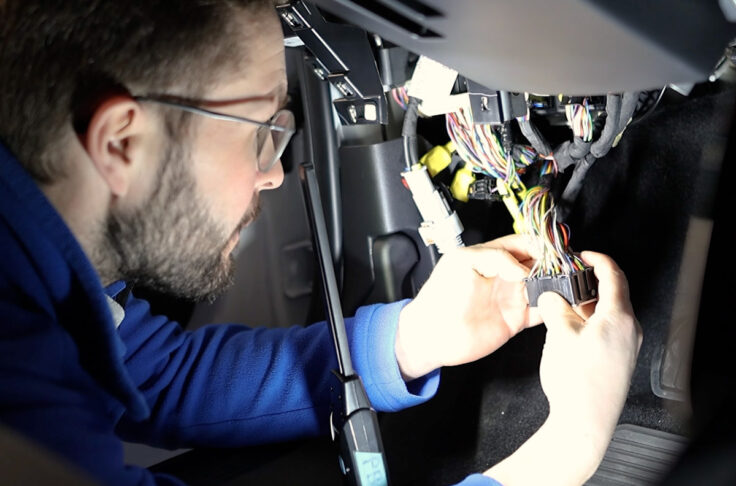Unpacking Car Sharing Technology: CAN, OBD & OEM Telematics

Summary
Car sharing operators rely on three core technologies to access vehicle data: direct CAN bus integration, OBD ports, and built-in OEM telematics. Direct CAN integration offers the most comprehensive data and security but is the most complex to install. OBD ports are easy to install for basic diagnostics but lack deep data and are less secure. OEM telematics eliminate hardware installation but create vendor dependency and integration challenges. Understanding these differences is essential for operators to optimize fleet management, control maintenance, and build a flexible, scalable service.
Car Sharing Technology: Boosting Shared Mobility
Since the introduction of the CAN bus in 1986, more and more vehicle data has been made available over time. The original system was designed to reduce the complexity and cost of wiring in automobiles, but soon attracted attention for data collection.
The OBD, standardized in 1996, offered an additional data source for telematics systems. Connected to the CAN bus, it made various data points such as speed, engine health, and diagnostic trouble codes accessible. Car rental and shared mobility services were able to make immediate decisions and take prompt action based on real-time data transmission.
In the early 2000s the Internet of Things (IoT) started to connect vehicles, operators, and users, allowing data flow and automation with enhanced connectivity. Cars outfitted with more computer systems, better network standards and the spread of smartphones have created new opportunities for the car sharing business model. Station-based, peer-to-peer or free-floating car sharing established a seamless experience for customers. With more people considering shared vehicles a viable alternative to personal vehicle ownership, the car sharing market has experienced significant growth. This led to the modern-day solution of the business model with comprehensive telematics platforms that aggregate collected data.
These multi-functional platforms offer comprehensive suites of features, including in-depth analytics, AI-based damage detection, driving behavior analysis, and fleet-wide monitoring. As an alternative to the integration of telematics units via CAN or OBD, some OEMs have recently started to implement factory-installed telematics. All of these capabilities provide car sharing services the ability to integrate with various other systems and car sharing technologies, ensuring a seamless operational experience.
Different Car Sharing Technologies and Their Advantages
Telematics Integration via CAN Bus
The CAN (Controller Area Network) bus provides a way of communication and data exchange for the different ECUs (Electronic Control Units) in the vehicle. This allows, for example, the engine and brakes to communicate with each other. CAN was developed by Bosch in 1986 and standardized by ISO 11898 in 1993.
The CAN bus gathers all data points related to in-vehicle communication.
To access CAN bus data, operators need a connector to link CAN to the telematics unit. As there is no standardized connector, telematics providers must cut wires. This can make integration more complex as they need to do a CAN analysis and provide custom instructions for each vehicle. Depending on the quality and intensity of that analysis, operators will get the most data from CAN.

Advantages:
- Comprehensive Data Insights: Access to most of the in-vehicle data for better operational decisions and diagnostics capabilities
- Capabilities: Depending on the model, CAN lets operators control several vehicle functions
- Modular Flexibility: Possibility to add additional features
- Reliability: CAN systems are designed to be extremely robust
- Security: More hidden and less known than OBD port, so it is better protected against manipulation and vandalism
Drawbacks:
- Expert Analysis Required: Data only available after comprehensive CAN analysis
- Barrier to Entry: Most complex installation compared to other options
- No DTCs: Time-intense to solve problems without Diagnostic Trouble Codes
Telematics Integration via OBD
OBD (On-Board Diagnostics) is a universal port enabling connection of various diagnostic tools in a car. It provides access to vehicle subsystems for monitoring, diagnostics and reporting purposes. In the late 1980s, the California Air Resources Board (CARB) developed the port and standardized it after 1996 with the implementation of OBD-II. Cars in the US are required to be equipped with OBD since 1996, the EU established a similar regulation in 2003.
Telematics connected via OBD can collect basic data such as engine performance, fuel efficiency, emissions, and error codes.
Integrating a telematics unit via OBD involves physical OBD hardware being plugged into the OBD connector. Once connected, operators can send requests via CAN and will get the response from the relevant ECUs.

Advantages:
- Ease of Installation: Quick, plug-and-play installation without professional assistance
- Cost-Effectiveness: More affordable than advanced CAN-integrated telematics, ideal for budget-conscious operators
- Diagnostic Capabilities: Provides essential engine health diagnostics to prevent major repairs
Drawbacks:
- Limited Data Insights: Basic engine diagnostics only; less in-depth data compared to advanced technologies
- Security Concerns: OBD devices are more vulnerable to be stolen or attacked, posing risks on vehicle safety and data integrity
- Limited Control: Less, if any at all, control of vehicle functions and data
OEM Telematics
Telematics pre-installed by an OEM (Original Equipment Manufacturer) are an integrated system designed for remote monitoring and control. First OEM to pre-install telematics was GM with OnStar in 1996. This car sharing technology eliminates the need for operators to install aftermarket telematics.
OEM telematics provide access to extensive data from various vehicle systems, including engine performance, location, and diagnostic codes.
OEM telematics come with pre-installed hardware, including sensors, GPS, and communication modules. However, operators are therefore forced to use the OEM API. This requires development resources to integrate and maintain the API. Additionally, operators will need to integrate a separate API for each manufacturer that they want to use vehicles from. The first APIs are already available today and the trend is going towards more OEMs offering pre-installed telematics. But the question remains how open they’ll be to let car sharing operators access their APIs and data.

Advantages:
- Natively Integrated with Vehicle: Built-in systems ensure compatibility and performance
- Broad and Additional Data: Dependent on OEM cooperation, vast amounts of data and commands are available
- Faster Infleeting: No installation of aftermarket telematics needed after API integration
Drawbacks:
- OEM Restrictiveness: OEMs keep several data points encrypted for operators
- OEM Dependency: Reliance on vehicle manufacturers for updates and support
- Limited Flexibility: Fewer options for customized features and limited selection of vehicle models
- No Standardization: API integration and standardization requires development resources or assistance of a 3rd party API aggregator
- Integration Effort: Large workload and maintenance effort for each OEM API
Car Sharing Technology Overview
Each technology has its own set of advantages and disadvantages. While integration via CAN can provide access to a great amount of data, OEMs are still hesitant to grant operators full access to their data. Integration via OBD is comparatively straightforward, but also has its limitations. Here is an overview of the three technologies:

Frequently Asked Questions About Car Sharing Technology
What is the main difference between CAN bus and OBD integration for car sharing technology?
The OBD port is a standardized, plug-and-play diagnostics port, making it easy to install but offering limited data. Direct CAN bus integration is more complex, requiring expert analysis, but it provides access to the most comprehensive and detailed vehicle data (e.g. door and window status), which is crucial for advanced operational control.
Why isn’t OBD always recommended for professional car sharing?
While OBD is simple, it offers very basic data (mostly engine diagnostics) and limited to no vehicle control. It’s also less secure, as the plug is easily accessible and can be tampered with or stolen. Professional operators typically require the deeper data, vehicle control, and security provided by direct CAN integration.
Are OEM telematics the future for all car sharing fleets?
While OEM telematics are a growing trend and eliminate hardware installation, they create dependency on the manufacturer. Each OEM has a different API that requires separate, resource-intensive integration and maintenance. This can also limit data access and flexibility compared to a dedicated aftermarket solution.
How can I manage a mixed fleet with both OEM API vehicles and other models?
This is a primary challenge for scalability. The most effective solution is to use a technology platform that can aggregate and normalize data from multiple sources. For example, INVERS’s platform integrates data from both OEM APIs (like Tesla’s) and aftermarket telematics (like the CloudBoxx) into a single, standardized API for your operations.
Choose the Right Car Sharing Technology for Your Business
Staying flexible and being able to adapt to market conditions is a key challenge for car sharing operators. A solution that covers CAN, OBD and OEM telematics is the optimal choice for your shared mobility business.
INVERS is here to assist you on this. Since 1993, we have been at the forefront of car sharing technology, shaping the future of shared mobility. Our unparalleled expertise and innovative solutions have empowered over 450 mobility services in more than 60 countries, including industry giants like Europcar, Hertz, Miles, Free2Move, and Getaround.
Our cutting-edge CloudBoxx is compatible with CAN or OBD. We have 30+ years of experience in analyzing CAN buses from the most common vehicles (900+), allowing you to collect all the vehicle data you need. If you choose OEM Telematics, our OEM integrations harmonize all OEM-APIs to one single, customer-centric API, eliminating the need to integrate and maintain different OEM Telematics.
Contact us to discover what’s the best car sharing technology for you and how INVERS can help you to optimize your car sharing business.


